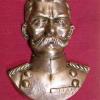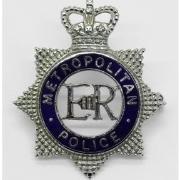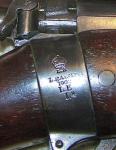-
Posts
20 -
Joined
-
Last visited
Profile Information
-
Gender
Male
-
Location
South Africa
-
Interests
Collecting British & Commonwealth Muskets, Rifles and bayonets 1810 to 1970 with particular interest in those of the Natal Volunteers 1854 to 1912.
Recent Profile Visitors
3,601 profile views
terrylee's Achievements
-
terrylee started following The Boer War Long Lees
-
Lee Metford Rifles: Mks I*, II & II*. Cavalry Carbine Mk I Lee Enfield Rifles: Mks I, & I*. Cavalry Carbines Mks I & I*
- 1 reply
-
1
-

Victorian 3 sided bayonet.
terrylee replied to Farkas's topic in Great Britain: Militaria: Badges, Uniforms & Equipment
Appears to be a Pat. 1876 bayonet to fit the Martini Henry. -
The Colonel started following terrylee
-
-
-
-
Very interesting. The last lot of Patten 1888 bayonets like those that I saw with broken blades from the Magersfontein area came from the graves of Scottish soldiers when they were moved in the 1960s. It would seem that it was a Highland tradition to break the blade of the bayonet belonging to the fallen soldier upon burial.
-
In support of Harry's post I attach photos of the rifles to which he referred. From top to bottom (In brief!): (1) Magazine Lee Enfield Mk.I. (2) Short Magazine Lee Enfield Mk.I. (3) Short Magazine Lee Enfield Mk.II*. (Conversion of earlier Lee Metfords and Lee Enfields to S.M.L.E. configuration) (4) Short Magazine Lee Enfield Mk.III. (No.1 Mk.III) (5) Short Magazine Lee Enfield Mk.III*. (No.1 Mk.III*) Slightly simplified verssion of the Mk.III introduced in 1916 to speed up wartime production) At the risk of appearing to be a little pedantic, I need to mention that the terms "No.1Mk.I" and "No.1 Mk.II" are technically incorrect. By the time that the No.1 nomenclature was introduced in the 1920s, the S.M.L.E.s Mk.I and II were obsolete and it was not officially applied to them.
-
Hi Elliot, I have no doubt that your rifle was originally manufactured by L.S.A. as a sporter, the first by that company that I have come across. The typical characteristics of a Lee sporter are as follows: 1) Six round magazine. 2) Sporter style butt. 3) No machined recess for the rear part of the long range sight. 4) Express-style rear sight. 5) Sporting-style front sight. Whereas (1) and (2) are easily attached to any Lee Enfield, (3) to (6) are built in characteristics of a sporting rifle. (3) is particularly distinctive. I attach a photo of a similar Lee Enfield sporting rifle manufactured by the Birmingham Small Arms Company. Regards, Terry
-
Hi Peter, Thank you for a very worthwhile post. Your theories are amongst the most interesting that I have encountered in my 40 years+ of collecting Lee Enfields. Upon what do you base them? What reference books do you use? I'd like to have a look at them myself. One is never too old to learn! Actually, its quite amazing what new information can be picked up on the internet. I was always under the impression that the first smokeless propellent used by the British, cordite, was introduced in 1892 and that it was the Short Magazine Lee Endield which replaced the Magazine Lee Enfield in 1903. Regards, Terry
-
London Small Arms Company. A private concern which operated from 1866 to 1925. It also produced Lee Enfields for the British Government, but such military contract rifles would have been marked with a crown and the date of manufacture as shown in the attached photos of slightly earlier and later L.S.A. rifles. The rifle queried probably started off as a commercially produced version of the contemporary military pattern such as those sold to private individuals or colonial governments, etc. If so, it was sporterised at a later date. It is also possible that the rifle in question was originally produced by L.S.A. in sporting configuration. However, in that event the "I" indicating the Mk.I version would probably not have been shown. More detailed photos and one of the whole rifle would probably decide the matter.
-
Hello Brian, I'm afraid that I have to disagree with your identification of the "shorter bayonet" as being a cut down version of the Pattern 1887 Mk III. I attach a photo of the Swinburn Bowie Knife Bayonet alongside a Pat. 1887 Mk.III for comparison. As you can see there are several very significant differences including length of hilt. And I can also confirm that the bowie will NOT fit a Martini Henry Mk.IV. I can take a photo of that too if necessary! For information on the Swinburn Henty Carbine Bayonet I can refer those who are interested to Skennerton's book, "British and Commonwealth Bayonets", pages 365 - 366. 190 of these bayonets were imported by the Natal Government with the early carbines over the period 1876 - 1878 and issued mainly to the Natal Mounted Police and Alexandra Mounted Rifles. There is also a photograph of Piet Uys with a Swinburn Carbine and Bowie Bayonet. As could be expected these bayonets were not particularly successful and I have only come across one personal account of their use. This was in the case of a mounted volunteer who was disarmed by a Zulu of his carbine with attached bayonet. He referred to it as a "foolish thing". So far as I'm aware the Swinburn carbine and bayonet had no artillery use at all, being confined to the mounted volunteers and mounted police. Being commercial production, they had to conform to no recognised pattern and somebody obviously had the bright idea that mounted volunteers and police would benefit from being equipped with bayonets! The fact that only 190 bayonets were issued with the early carbine orders is probably very significant. They are consequently now extremely rare. Regards, Terry
-
Some more Zulu War Rifles. The Swinburn Henry Rifles and Carbines were on issue to the Natal Volunteers from 1875 and remained in service until 1894. From top to bottom: Swinburn Henry Rifle as issued to the volunteer infantry regiments with pattern 1871 Cutlass Bayonet and commercial Pattern 1875 Bayonet. Although on issue during the Zulu War, it is unlikely that the rifles and Pattern 1875 bayonets saw active service since the regiments so equipped served as town guards during hostilities. The 1871 Cutlass Bayonets were ex-naval issue and were only received to equip the Natal Naval Volunteers when they were formed in 1885. Swinburn Henry Carbine with Bowie Knife Bayonet. The carbines were issued to the mounted volunteers, who served as scouts during the Zulu War, and also to the Natal Mounted Police. The carbine bayonets were of limited issue and primarily saw service with the Alexandra Mounted Rifles and the Natal Mounted Police. Carbines equipped the Natal Volunteers at Isandhlwana and the Mounted Police would also have carried the bayonets. The carbine in the photo has the low issue number of 69 and thus quite possibly saw active service in the Zulu War.


.thumb.jpg.dc117d4800dc2a7ad9d9cc54cdbccc88.jpg)











